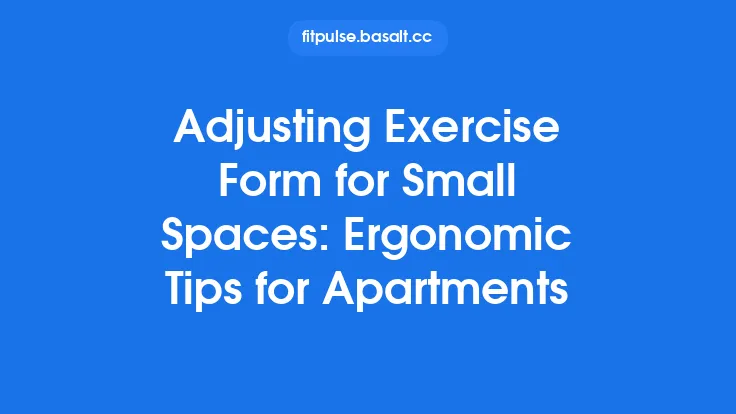The modern home gym has become a staple for many, yet not everyone has the luxury of a dedicated workout room. Whether you live in a studio apartment, share a loft, or simply want to keep your living area uncluttered, the challenge is the same: how to fit effective, technology‑driven training into a limited footprint. By combining smart functionality with space‑saving design, you can create a versatile fitness hub that feels larger than it is, tracks progress, and adapts to your evolving goals—all without sacrificing style or comfort.
Understanding the Constraints of Small Home Gyms
Before diving into equipment choices, it’s helpful to map out the specific limitations you’re working with:
| Constraint | Typical Impact | Mitigation Strategy |
|---|---|---|
| Floor Area | Limited square footage restricts movement and equipment placement. | Prioritize multi‑axis devices that require minimal swing radius (e.g., vertical rowers, compact ellipticals). |
| Ceiling Height | Low ceilings can make overhead movements unsafe. | Opt for low‑profile machines and wall‑mounted rigs that stay within a 7‑ft envelope. |
| Storage Options | Lack of closets or shelves leads to clutter. | Choose foldable or wall‑mounted gear that tucks away when not in use. |
| Noise Sensitivity | Thin walls or shared spaces demand quieter operation. | Select devices with magnetic resistance or silent motor technology. |
| Aesthetic Integration | A gym that looks out of place can affect motivation. | Choose equipment with sleek finishes and smart displays that blend with home décor. |
By cataloguing these constraints, you can target solutions that address each pain point directly, ensuring that the final setup feels intentional rather than improvised.
Core Principles of Compact Smart Gym Design
- Modularity – Devices that can be reconfigured or combined reduce the need for separate pieces. A smart cable tower that doubles as a pull‑up bar and a squat rack exemplifies this approach.
- Vertical Utilization – The walls are often underused. Wall‑mounted smart mirrors, sensor‑embedded panels, or fold‑down benches free up floor space while still delivering full‑body workouts.
- Dual‑Functionality – Equipment that serves more than one training modality (e.g., a smart adjustable dumbbell that also tracks reps via built‑in accelerometers) maximizes ROI.
- Integrated Tracking – Built‑in sensors eliminate the need for separate wearables or external cameras, keeping the space tidy and the data centralized.
- Minimal Footprint, Maximum Output – Look for devices that deliver high resistance or cardio output within a compact chassis, such as magnetic‑resistance rowers that occupy a 2‑by‑3‑foot footprint.
Applying these principles ensures that every square inch contributes to your fitness goals rather than becoming dead space.
Multi‑Functional Smart Equipment for Tight Spaces
| Device | Smart Features | Space‑Saving Attributes | Primary Benefits |
|---|---|---|---|
| Smart Adjustable Dumbbells | Integrated gyroscope, Bluetooth to app, auto‑weight detection | Replace an entire rack of plates; each dumbbell occupies ~5 × 5 in. | Instant weight changes, precise rep counting, progressive overload tracking. |
| Compact Smart Rowers (Vertical Design) | Magnetic resistance, heart‑rate sensor, AI‑driven interval coaching | Upright orientation reduces floor area; can be stored vertically against a wall. | Full‑body cardio, low‑impact, high calorie burn in a small footprint. |
| Fold‑Down Smart Bench | Load‑cell weight sensors, app‑guided form correction, quick‑lock hinges | Hinged to fold flat against a wall; occupies <2 sq ft when stored. | Supports bench press, step‑ups, and seated rows without a permanent bench. |
| Wall‑Mounted Smart Cable System | Motorized resistance, programmable workout libraries, digital tension readout | Mounted on a single wall panel; cables retract when not in use. | Enables pull‑ups, rows, triceps extensions, and functional training with minimal floor clutter. |
| Smart Mirror with Integrated Resistance Bands | Real‑time video coaching, band tension sensors, AI form analysis | Thin (≈1 in.) panel that doubles as a mirror; bands stored in a discreet sleeve. | Provides guided workouts, visual feedback, and resistance training without bulky equipment. |
These devices illustrate how a single piece can replace multiple traditional machines, delivering a comprehensive training experience while staying compact.
Wall‑Mounted and Foldable Solutions
Wall‑Mounted Smart Mirrors
Beyond their reflective surface, these mirrors embed cameras and depth sensors that analyze movement, count reps, and suggest corrections. Because they are essentially a flat panel, they occupy no floor space and can be positioned at eye level for optimal ergonomics.
Fold‑Down Smart Benches
Modern hinges and locking mechanisms allow a bench to be raised for use and then folded flush against a wall or under a shelf. Some models incorporate load cells that automatically log the weight lifted, syncing with your fitness app without extra hardware.
Vertical Cable Towers
Traditional cable machines require a large footprint, but a wall‑mounted version uses a motorized pulley that slides up and down a vertical rail. When not in use, the rail can be lowered to a compact height, and the cables retract into a concealed housing.
Compact Smart Ellipticals
These devices use a “sliding footplate” design that shortens the stride length while preserving the elliptical motion. The entire unit can be tipped onto its side for storage, reducing its footprint by up to 40 %.
When selecting wall‑mounted or foldable gear, verify the mounting hardware’s load rating and ensure the wall studs can support the dynamic forces generated during intense workouts.
Smart Adjustable Weight Systems
Traditional weight stacks are bulky and often require manual pin changes. Smart adjustable systems replace this with electronically controlled plates:
- Electro‑Magnetic Weight Plates – Each plate contains a small electromagnet that can be activated or deactivated via a central console or mobile app. The system can instantly shift from 5 lb to 50 lb in 1‑second increments.
- Digital Load Cells – Integrated into the bar or handle, load cells provide real‑time weight readouts, eliminating guesswork and ensuring accurate progressive overload.
- Auto‑Calibration – Upon power‑up, the system runs a quick self‑check to verify plate positions, guaranteeing that the displayed weight matches the actual load.
These systems are especially valuable in small spaces because a single bar can replace an entire rack of plates, and the digital interface eliminates the need for a separate weight‑tracking notebook.
Integrated Tracking and AI in Compact Devices
Even the smallest smart gym devices now come equipped with sophisticated sensors:
- Inertial Measurement Units (IMUs) – Accelerometers and gyroscopes capture motion vectors, allowing the device to count reps, detect range of motion, and assess tempo.
- Force Sensors – Placed in handles or footplates, they measure applied force, providing data on power output and symmetry.
- Heart‑Rate Integration – Some compact rowers and ellipticals embed optical heart‑rate sensors directly into the grips, removing the need for a chest strap.
- AI‑Driven Coaching – By analyzing sensor data, onboard AI can suggest adjustments (e.g., “increase stride length” or “maintain a consistent cadence”) and automatically adjust resistance to keep you within target zones.
All data syncs to a central hub—often a smartphone app—where you can view trends, set goals, and receive personalized workout plans. Because the hardware handles data capture, you avoid cluttering the space with external wearables or cameras.
Optimizing Layout: Zoning and Flow
A well‑thought‑out layout not only maximizes usable space but also enhances safety and workout efficiency. Consider these zoning principles:
- Warm‑Up Zone – Allocate a 3‑by‑3‑ft area near the entrance for light cardio (e.g., a compact smart rower) and dynamic stretching. Keeping this zone separate prevents traffic congestion.
- Strength Zone – Position the smart adjustable dumbbells and fold‑down bench against a wall, leaving a clear 4‑ft radius for free‑weight movements. If you have a wall‑mounted cable system, mount it opposite the bench to create a balanced push‑pull layout.
- Cardio/HIIT Zone – Place a vertical elliptical or mini‑treadmill (if you have one) in a corner where the ceiling height is sufficient. Ensure there’s at least 2 ft of clearance behind the device for safe entry and exit.
- Recovery Zone – A small mat or foam roller area can double as a storage spot for yoga blocks or resistance bands, keeping the floor tidy.
Use floor‑level markers (e.g., low‑profile tape or rubber mats) to delineate each zone visually. This helps maintain flow, especially when multiple people share the space.
Leveraging Smart Home Integration for Space Efficiency
Smart gym equipment can communicate with broader home automation platforms (e.g., Apple HomeKit, Google Home, Amazon Alexa). While deep connectivity details are beyond the scope of this article, a few practical integrations can streamline your workout environment:
- Voice‑Activated Power – Command your smart mirror to turn on, start a specific workout, or adjust lighting without reaching for a remote.
- Dynamic Lighting – Sync the room’s smart bulbs to change color temperature based on workout intensity (cool blues for cardio, warm ambers for cooldown).
- Climate Control – Trigger your thermostat to lower the temperature a few minutes before a high‑intensity session, ensuring comfort without manual adjustments.
- Audio Integration – Connect the equipment’s Bluetooth speaker to your home sound system, allowing seamless transition between workout playlists and ambient music.
These integrations reduce the number of physical devices you need to manage, keeping the space uncluttered and the user experience fluid.
Choosing the Right Compact Smart Gym Setup for Your Goals
When evaluating options, align the equipment’s capabilities with your primary fitness objectives:
| Goal | Recommended Compact Smart Devices | Why It Fits |
|---|---|---|
| Full‑Body Strength | Smart adjustable dumbbells + fold‑down bench + wall‑mounted cable system | Covers compound lifts, isolation work, and functional training without a full rack. |
| Cardiovascular Conditioning | Vertical smart rower or compact elliptical | High calorie burn, low impact, minimal floor space. |
| HIIT & Functional Training | Smart mirror with integrated resistance bands + wall‑mounted cable system | Provides guided intervals, visual feedback, and versatile movement patterns. |
| Rehabilitation & Mobility | Smart mirror + low‑profile foam mat + adjustable dumbbells (light weights) | Offers precise form correction and gentle resistance. |
| Space‑Constrained Multi‑User | Smart adjustable dumbbells + fold‑down bench + wall‑mounted mirror (shared schedule) | Quick transitions between users, minimal storage needs. |
Consider the weight capacity of each device, the maximum resistance it can deliver, and the software ecosystem (e.g., compatibility with your preferred fitness app). A well‑matched set will keep you motivated and reduce the temptation to abandon workouts due to space frustrations.
Practical Tips for Maintaining an Organized Small Gym
- Routine Declutter Sessions – Spend 5 minutes after each workout to return equipment to its designated spot. This habit prevents gradual accumulation of gear.
- Use Wall‑Mounted Racks – Even lightweight accessories like kettlebells or medicine balls can be hung on slim wall racks, freeing floor space.
- Cable Management – For devices that require power, use short, flat power strips mounted behind furniture to keep cords out of sight.
- Label Zones – Small stickers or magnetic labels on the floor can remind you where each equipment piece belongs, especially useful for shared spaces.
- Periodic Re‑Assessment – Every 3‑6 months, evaluate whether any piece is under‑utilized. Removing or swapping out seldom‑used gear can open up valuable space for new activities.
By integrating these habits, your compact smart gym will stay functional, inviting, and ready for every workout—no matter how limited the square footage.





